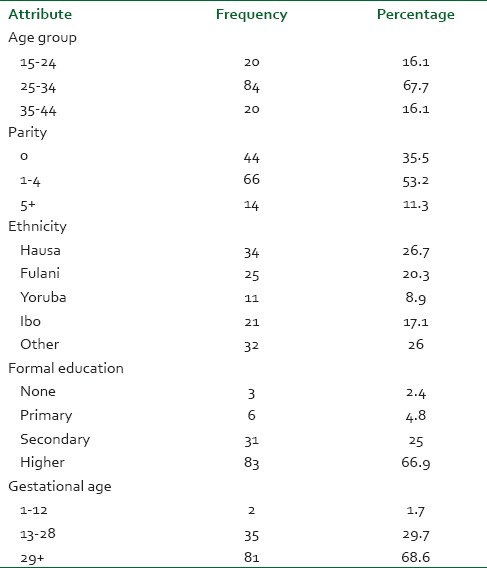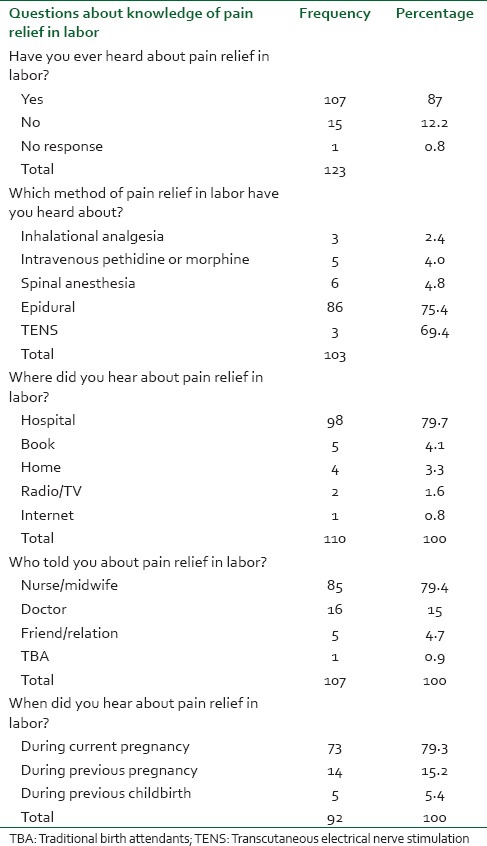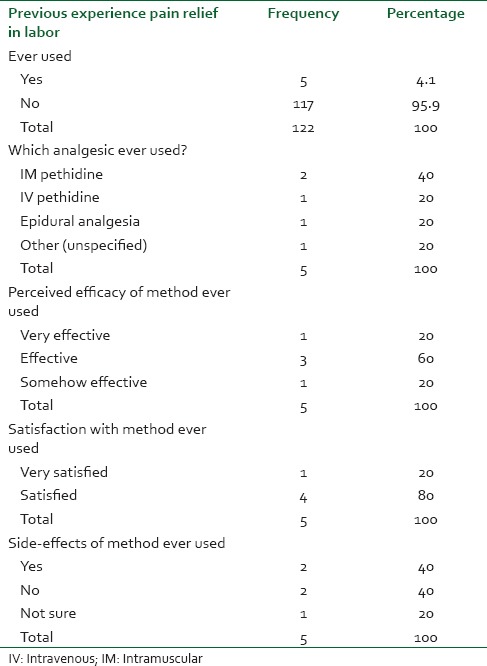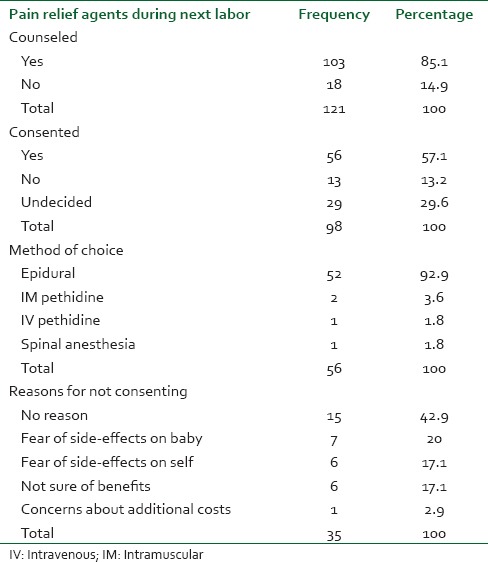Abstract
Background:
Pain relief in labor remains a hot topic and these debates get louder by the day as more women become aware of their rights to better quality of care in labor. This study was conceived in a background where the practice of pain relief in labor is evolving and where women are seeking to fulfill their need for pain-free labor.
Objective:
To investigate the knowledge, utilization and preferences of methods of pain relief in labor by expectant mothers in order to design a labor analgesia program.
Materials and Methods:
A questionnaire-based descriptive study involving 124 antenatal clients in a teaching hospital over a 1 week period. Descriptive statistics were carried out using SPSS for windows version 17.
Results:
The mean age of clients was 28.8 years (standard deviation = 5.17) with median parity of two and mean gestational age was 31.5 weeks. Majority of the respondents (47.9%) were of Hausa/Fulani ethnicity and 97.6% had primary school level education. Majority (87.3%) had heard about pain relief methods with the hospital being the source in 79% of cases. The most common method ever heard about was epidural analgesia (69.4%). Only 4% (n = 5) of respondents remembered ever using any form of pain relief agent in labor, of which three received parenteral opioids. In their current pregnancies, 45.2% consented to the use of pain relief in labor; of which, epidural analgesia was preferred by 92.9% (n = 52). Fear of adverse effects on self and infants were cited as reasons for non-consent by some respondents while others had no reason.
Conclusion:
The study reveals a high awareness of pain relief methods which is not matched by utilization and low knowledge about side-effects, although fear of side-effects is a factor for under-utilization. There is a need to educate adequately as well provide high quality pain relief services in labor in order to dispel with myths, misconceptions and fears associated with the use of methods of pain relief in labor.
Keywords: Antenatal clients, epidural analgesia, knowledge, labor, Pain relief, preferences
INTRODUCTION
The excruciating nature of the pain of labor makes it an experience most women will want to avoid. For an expectant mother, labor pains would always be a source of worry and pain relief agents or methods would remain of much interest. Even for obstetric care providers the search for the ideal pain relief agent in labor continues to be a subject of much interest and research.[1] However, some studies show the ambivalence or outright refusal of providers to offer labor analgesia, especially in low resource settings.[2,3]
The context in which obstetric care with the provision of labor analgesia is offered is important. In high income, egalitarian societies there has been great momentum toward pain-free labor with near-universal utilization of pain relief agents and debates shifting from availability to quality of pain relief services in labor.[4] However, in low income countries where women are burdened with high pregnancy rates and short inter-pregnancy intervals, pain relief in labor remains a distant reality and so even where knowledge is high, utilization is low.[4,5,6]
As more expectant mothers become aware of the possibility of pain-free labor, linked to their rights to improved quality of obstetric care, their expectations for the use of pain relief agents during labor and delivery is bound to increase.[7] The type, safety and effectiveness of pain relief agents would also become important topics for women and their families. However, little information is available on what women know about pain relief agents and even less information is available to women about the choices available to them. This study hopes to raise conversations on the perspectives of expectant mothers on pain relief utilization in labor. It primarily seeks to investigate the knowledge, preferences and utilization and of pain relief agents in a cohort of antenatal women.
MATERIALS AND METHODS
This study was carried out among women attending antenatal clinic in a tertiary health facility in northern Nigeria. Northern Nigeria is known for low levels of obstetric care utilization, high maternal mortality and low female education.[8] Majority of women deliver at home without the use of pain relief agents. Even the women that deliver within the health care facilities may have little or no access to labor pain relief information and services.
The antenatal clinic used for this study is patronized by a diversity of clients, including the natives, mostly Hausa/Fulani women and settlers from other parts of Nigeria and beyond. With this client diversity, knowledge and choices for pain relief agents during labor could be diverse and information generated could be useful in designing a suitable labor analgesia protocol.
The study was descriptive using a structured, pre-tested questionnaire in the English language consisting of socio-demographic questions and questions related to knowledge, preferences and utilization of most common pain relief agents available in the hospital. Antenatal care nurses were trained on the use of the questionnaire and administered it to the clients irrespective of their educational status.
A total population survey was planned for the estimated 150 clients who utilize antenatal services weekly in the hospital. Each client was counseled about the study and served with the questionnaire after verbal consent was given. Consecutive clients were interviewed over a 1 week period in October 2011.
Descriptive statistics were carried out on the data using SPSS for windows version 17 (SPSS Inc. Released 2008. SPSS Statistics for Windows, Version 17.0. Chicago: SPSS Inc). Chi-square was use for the test as statistical significance, P < 0.05 was considered to be statistically significant.
RESULTS
The mean age of clients was 28.8 years (standard deviation = 5.17) with median parity of two children and their mean gestational age was 31.5 weeks at the time of the study. The majority of the respondents (47.9%) were of Hausa/Fulani ethnicity and 97.6% had at least primary school level education. Table 1 below shows details of the demographic and obstetric characteristic of the respondents.
Table 1.
Demographic and obstetric characteristics of respondents

Awareness of pain relief in labor by respondents
Table 2 shows details of characterization of the respondents’ access to information about pain relief in labor. The majority had been informed about pain relief in labor largely from their health care providers (midwives) in the health care facilities, which they patronize. Most were provided this information in their current pregnancy.
Table 2.
Characterization of respondent's access to information about pain relief in labor

Previous experience with utilization of pain relief agents
Table 3 describes the experience of the respondents with utilization of pain relief agents in labor. In this study population, only five women (4.1%) recollected that they have ever been provided with pain relief agents in labor and the most common was parenterally administered pethidine.
Table 3.
Respondent's previous experience with pain relief agents in labor

Decision for utilization of pain relief agents during delivery of index pregnancy
The respondents’ access to information/counseling in their index pregnancy is as shown in Table 4. The majority had been counseled with 56 (57.1%) consenting to the use of pain relief agents during delivery of their index pregnancy. Of the consenting respondents, the majority opted for epidural analgesia. For non-consenting women, the majority gave no reason while fear of side-effects on baby and self, and lack of assurance of benefits were cited by some.
Table 4.
Uptake of pain relief agents during next labor

Levels of education with the knowledge of labor pain control
Association between the levels of education with the knowledge of labor pain control is shown in Tables 5 and 6 below. Table 5 shows that knowledge of any method of pain relief in labor and educational level was not statistically significant (P = 0.637). However, Table 6 shows that there is statistically significant difference between educational level and knowledge of side-effects of pain relief methods with a P = 0.0001.
Table 5.
Knowledge of any method of pain relief in labor and educational level

Table 6.
Educational level and knowledge of side-effects of pain relief methods

DISCUSSION
In this mixed population of expectant mothers, the majority have heard about pain relief in labor; mostly from their caregivers and during the current pregnancy. This high level of awareness contrasts with a finding from another tertiary hospital in the south of Nigeria in 2003 in which only about a quarter of antenatal care clients were aware of pain relief in labor.[9] The high level of awareness in our study could be attributed to increasing discussions on the topic during antenatal health talks in that institution as part of a project conducted by the authors or an increased level of conversation in the media.
The authors asked some basic characteristics like education level, which is really important for the awareness of labor pain control. However, analysis of the association between the levels of education with the awareness of the pain control was not statistically significant. However, there is statistically significant difference between educational levels and knowledge of side-effects of pain relief methods.
One important factor in the high awareness level could be the high level of education of the study population with more than 90% having obtained secondary level or higher qualification. For a tertiary level antenatal setting, such a high proportion of enlightened clients would not be unusual as the uneducated and low income mothers are likely not seek antenatal care at all or patronize lower levels of care. As such this level of awareness could be an over-representation of the real situation and could be much lower in community level studies. The implication of this finding is that as more women become educated, knowledge of pain relief in labor could increase exponentially, thereby driving the demand for services. Starting from tertiary level care givers, effort needs to be intensified to design and deliver realistic labor analgesia services in anticipation.
In terms of utilization however, only a small proportion of the mothers (4.1%) could recall ever use of labor relief agents of any sort, form or method. Such low levels of utilization are prevalent in many low-resource settings.[5] Of the five women with ever use, three recalled use of parenteral pethidine, which has no evidence base[1,10] with only one woman recalling ever use of epidural analgesia. One study showed low awareness for epidural analgesia among Nigerian women.[11] This paucity of information is not limited to Nigerian women and has been demonstrated by authors from other countries.[12] This is despite accumulating evidence in favor of epidural analgesia as the method of choice for pain relief in labor.[13] In our study, epidural analgesia was the most common method known to the subjects. This high level of awareness could be attributed to increasing discussions on the topic during antenatal health talks in that institution as part of a project conducted by the authors as a prelude to setting up a labor analgesia service. It could also be related to recent public and medical media focus on the potency and safety of this method as a labor analgesic. In summary, the utilization of pain relief agents is low and even in situations where there are used the most common method may not necessarily be the most potent and safe. The finding that all five mothers were satisfied with the method of labor analgesia used for them, despite the report of side-effects by some, could imply that many more mothers will be willing to avail themselves of these methods.
The majority of respondents (85.1%) admitted that they had been counseled to use pain relief agents during their next labor and delivery, out of which 57.1% consented. This again strongly suggests that many women in the study setting have a positive disposition to the use of use of pain relief agents in labor. The majority of the respondents’ preference for epidural analgesia emphasizes the need to build capacity for quality epidural service delivery minimizing side-effects while maximizing client satisfaction. This is especially necessary as a sizeable number of respondents who did not consent (n = 13) attributed it to fear of side-effects on self or baby while some were not even sure of the benefits. A Nigerian study also found fear as a factor among women who declined the used of pain relief agents in labor.[3] In addition to quality services, the provision of clear, accurate and appropriate information to expectant mothers will help them make realistic decisions concerning the utilization of pain relief agents during labor and delivery. Some studies attest the role of education in this regard.[14] Encouraging the participation of labor ward nurses to provide labor analgesia as contained in ACOG guidelines will greatly expand the capacity of health facilities to provide services to desiring mothers.[15]
Limitations of the study
It is not clear what level of awareness of this cohort of expectant mothers was before talks on pain relief in labor was instituted in this antenatal care facility. More Population based studies as opposed to facility based studies are needed on a larger number of women to establish the findings in this study and may eliminate some bias that might have affected the responses of the study population.
CONCLUSION
This study observed the situation of labor pain control in northern Nigeria and found a high awareness of pain relief methods, which is not matched by utilization and also found low knowledge about side-effects. In a setting with low levels of utilization of health care facilities for labor and delivery services, pain-free labor and delivery services could be a useful incentive to change negative attitudes and behavior to facility delivery. It is therefore important to include pain-free labor services as part of any comprehensive, quality obstetric care service package offered to women in the study setting.
Footnotes
Source of Support: Funding is partly from the IASP Developing Countries Education Grant 2010
Conflict of Interest: None declared.
REFERENCES
- 1.Jones L, Othman M, Dowswell T, Alfirevic Z, Gates S, Newburn M, et al. Pain management for women in labour: An overview of systematic reviews. Cochrane Database Syst Rev. 2012;3:CD009234. doi: 10.1002/14651858.CD009234.pub2. [DOI] [PMC free article] [PubMed] [Google Scholar]
- 2.Ogboli-Nwasor E, Adaji S, Bature S, Shittu O. Pain relief in labor: A survey of awareness, attitude, and practice of health care providers in Zaria, Nigeria. J Pain Res. 2011;4:227–32. doi: 10.2147/JPR.S21085. [DOI] [PMC free article] [PubMed] [Google Scholar]
- 3.Chigbu CO, Onyeka TC. Denial of pain relief during labor to parturients in southeast Nigeria. Int J Gynaecol Obstet. 2011;114:226–8. doi: 10.1016/j.ijgo.2011.04.006. [DOI] [PubMed] [Google Scholar]
- 4.Christiaens W, Verhaeghe M, Bracke P. Pain acceptance and personal control in pain relief in two maternity care models: A cross-national comparison of Belgium and the Netherlands. BMC Health Serv Res. 2010;10:268. doi: 10.1186/1472-6963-10-268. [DOI] [PMC free article] [PubMed] [Google Scholar]
- 5.Mung’ayi V, Nekyon D, Karuga R. Knowledge, attitude and use of labour pain relief methods among women attending antenatal clinic in Nairobi. East Afr Med J. 2008;85:438–41. doi: 10.4314/eamj.v85i9.117084. [DOI] [PubMed] [Google Scholar]
- 6.James JN, Prakash KS, Ponniah M. Awareness and attitudes towards labour pain and labour pain relief of urban women attending a private antenatal clinic in Chennai, India. Indian J Anaesth. 2012;56:195–8. doi: 10.4103/0019-5049.96331. [DOI] [PMC free article] [PubMed] [Google Scholar]
- 7.Lally JE, Murtagh MJ, Macphail S, Thomson R. More in hope than expectation: A systematic review of women's expectations and experience of pain relief in labour. BMC Med. 2008;6:7. doi: 10.1186/1741-7015-6-7. [DOI] [PMC free article] [PubMed] [Google Scholar]
- 8.Wall LL. Dead mothers and injured wives: The social context of maternal morbidity and mortality among the Hausa of northern Nigeria. Stud Fam Plann. 1998;29:341–59. [PubMed] [Google Scholar]
- 9.Olayemi O, Aimakhu CO, Udoh ES. Attitudes of patients to obstetric analgesia at the University College Hospital, Ibadan, Nigeria. J Obstet Gynaecol. 2003;23:38–40. doi: 10.1080/0144361021000043209. [DOI] [PubMed] [Google Scholar]
- 10.Bricker L, Lavender T. Parenteral opioids for labor pain relief: A systematic review. Am J Obstet Gynecol. 2002;186:S94–109. doi: 10.1067/mob.2002.121549. [DOI] [PubMed] [Google Scholar]
- 11.Oladokun A, Eyelade O, Morhason-Bello I, Fadare O, Akinyemi J, Adedokun B. Awareness and desirability of labor epidural analgesia: A survey of Nigerian women. Int J Obstet Anesth. 2009;18:38–42. doi: 10.1016/j.ijoa.2008.07.011. [DOI] [PubMed] [Google Scholar]
- 12.To WW. Quality Assurance Subcommittee in Obstetrics and Gynaecology, Hospital Authority, Hong Kong. A questionnaire survey on patients’ attitudes towards epidural analgesia in labour. Hong Kong Med J. 2007;13:208–15. [PubMed] [Google Scholar]
- 13.Nystedt A, Edvardsson D, Willman A. Epidural analgesia for pain relief in labour and childbirth-a review with a systematic approach. J Clin Nurs. 2004;13:455–66. doi: 10.1046/j.1365-2702.2003.00849.x. [DOI] [PubMed] [Google Scholar]
- 14.Boama V. Overcoming barriers to pain relief in labor through education. Int J Gynaecol Obstet. 2011;114:207–8. doi: 10.1016/j.ijgo.2011.06.004. [DOI] [PubMed] [Google Scholar]
- 15.ACOG Committee Opinion #295: Pain relief during labor. Obstet Gynecol. 2004:104–213. [PubMed] [Google Scholar]


